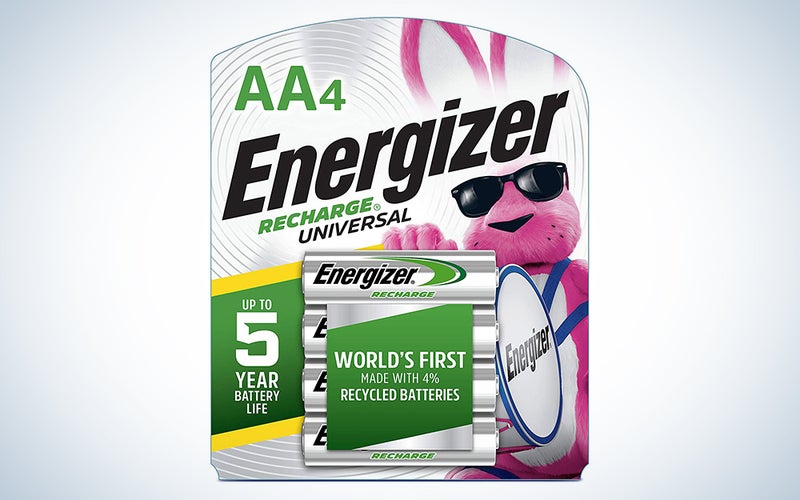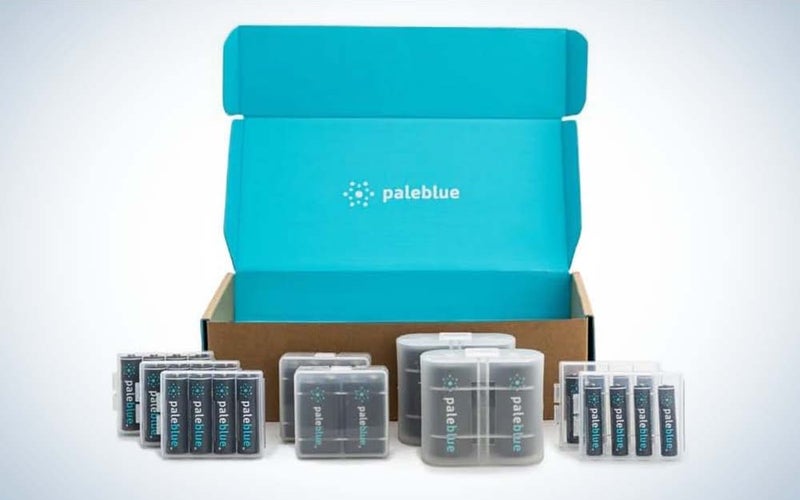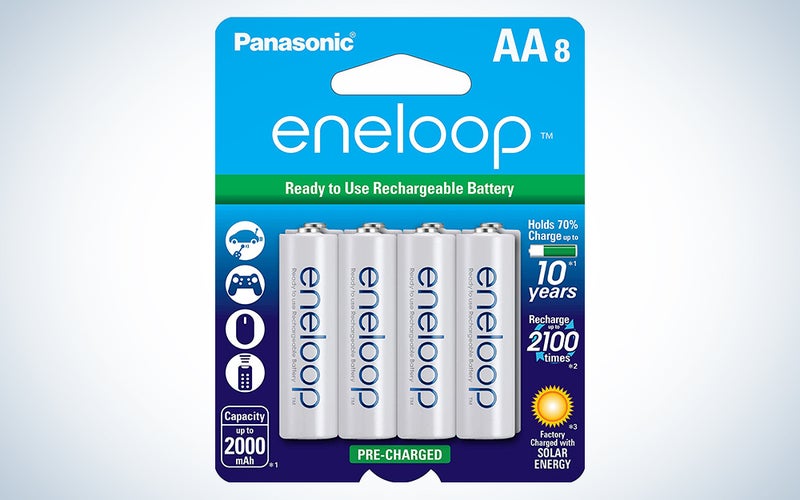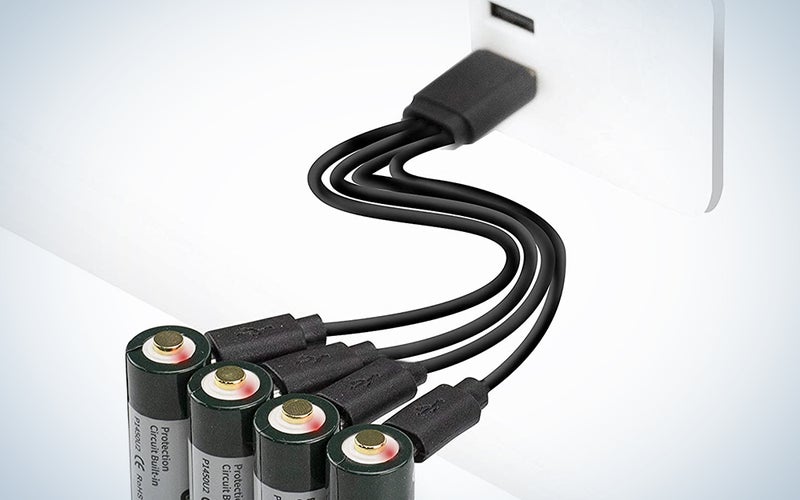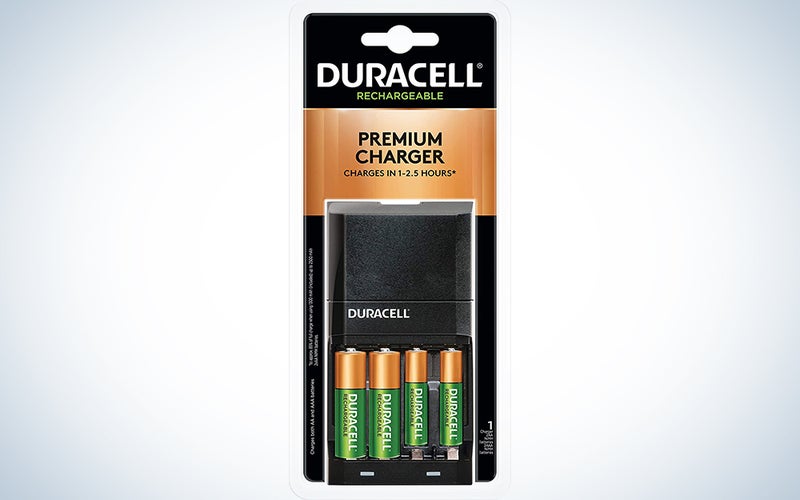We may earn revenue from the products available on this page and participate in affiliate programs. Learn more ›
There are some significant reasons to consider making the easy upgrade from using regular batteries to buying rechargeable batteries … easy unless you hate a good value, that is. With the best rechargeable batteries good for hundreds or even thousands of charge cycles, making that switch could save you a lot of money over time. Follow our recommendations and say goodbye to the days when you’d need one or two batteries but be forced to rush to a store to get a big, expensive, single-use pack just to get your remote back up and running. Additionally, you can recycle your rechargeable batteries. Kinder for your budget and the planet? Sign us up. If it sounds like the best rechargeable batteries are a good proposition all around, that’s because they are, so here are our picks in this win-win situation.
- Best overall: Energizer Recharge Universal AA Batteries
- Best bundle: Pale Blue Home Conversion Kit
- Best long-lasting: Panasonic eneloop AA Batteries
- Best value: AmazonBasics Performance AA Batteries
- Best USB-rechargeable: Keeppower USB Rechargeable Li-ion AA Batteries
- Best with charger: Duracell Ion Speed 4000 Battery Charger with Batteries
How we selected the best rechargeable batteries
To select the best rechargeable batteries, we looked at several scenarios and concerns and examined impressions from both professional and personal users. The methodology strived to identify the longest-lasting products with the most minimal environmental impact. We worked to identify batteries that could spring into action even when stored in a drawer for years, as well as options that come equipped with the latest conveniences, like USB charging that can be done directly to the battery with any compatible cable instead of using a more inconvenient apparatus.
The best rechargeable batteries: Reviews & Recommendations
While regular batteries drain over time until they’re bricks, rechargeable batteries are much more energy-efficient and hold a consistent charge throughout the battery lifespan. Using rechargeable batteries keeps more in your wallet and less in landfills, so making the switch can make a difference in your household and beyond. Not sure where to start? We’ve got you.
Best overall: Energizer Recharge Universal AA Batteries
Energizer
Why it made the cut: Energizer came up with the world’s first battery made with other recycled batteries.
Specs
- Comes pre-charged: Yes
- Charge cycles: Up to 1,000 times
- Capacity: Up to 2,000 mAh
- Sold in: 4, 8, 16, and combo packs
- Also available in: AAA, C, D, 9V sizes
Pros
- Made with recycled batteries
- Charge lasts 12 months in storage
- Up to 5 years of usable battery life
Cons
- Not pre-charged
- Some chargers only charge pairs
- Sensitive to overcharging
Energizer was the first to the market with a line of rechargeable batteries made with recycled materials—4% of the components inside are previously used batteries. These Energizer rechargeable batteries are made of nickel-metal hydride (NiMH) and are more environmentally friendly and can be charged up to 1,000 times at up to 2,000 mAh. They are available in quantities of four, eight, 16, and combo packs and also come in AA, AAA, C, D, and 9V sizes. While these particular rechargeable batteries do not come pre-charged and ready to use like some others in this round-up, once they are powered up, the charge lasts up to one year in storage, and you can also expect up to five years of usable battery life. One minor drawback is some customers have reported that this product can be sensitive to overcharging, so it’s best if they’re not plugged in to charge and left overnight.
Best bundle: Pale Blue Home Conversion Kit
Pale Blue
Why it made the cut: Pale Blue’s home conversion kit provides the main batteries any household will need, plus two USB chargers to keep them ready to go.
Specs
- Comes pre-charged? No
- Charge cycles: Up to 1,000
- Capacity: 1,560 mAh
- Sold in: Kit, with 12 AAA, eight AA, four D, four 9V batteries, and two USB chargers with four prongs
- Also available in: AA, AAA, C, D, 9V, and AA and AAA combo kit
Pros
- Kit comes with 28 batteries for comprehensive approach
- Charges in under two hours
- Comes with two four-pronged USB chargers
- You can buy comprehensive kit or individual batteries
Cons
- Expensive
- Must have USB-compatible plug for chargers to work
Tired of having to root around for a battery when your alarm clock or flashlight stops working? ? Pale Blue’s Home Conversion Kit provides the power you need—AAA, AA, 9V, and D batteries—all in one kit, letting you take a more holistic approach.The Utah-based company’s batteries charge up to five times faster than NiMH batteries. The batteries also come with a micro-USB charging port that lets you charge four batteries at a time. And their 1,000-charge cycles put them in line with other top long-lasting rechargeable batteries.
The company also invests in sustainability, donating a portion of their proceeds 1 Percent for the Planet. That said, if you don’t use a lot of batteries, this set is expensive and may lead to additional waste.
Best long-lasting: Panasonic eneloop AA Batteries
Panasonic
Why it made the cut: A reliable choice even if you put a pack in a drawer and forget about it for a long time.
Specs
- Comes pre-charged: Yes
- Charge cycles: Up to 2,100 times
- Capacity: Up to 800 mAh
- Sold in: 4, 8, and combo packs
- Also available in: AAA, C, D sizes
Pros
- Can be used worldwide
- Thousands of charge cycles
- Holds 70% charge after 10 years
Cons
- Company advises against third-party chargers
- Can get hot
- A short circuit can expel gas
Panasonic’s eneloop line of rechargeable NiMH batteries is pre-charged at the factory by the wonders of solar power, which is one thoughtful choice you can make as a consumer when looking for the best rechargeable batteries for your needs. If you’re guilty of just throwing your batteries in a drawer and rarely using them, let alone charging them, you can have the satisfaction of knowing that these claim to hold up to 70 percent charge even after 10 years. You will rarely have to think about replacing these batteries, even if you feel like you are a pretty frequent user of gear that requires them. The eneloop batteries are designed to be able to be charged up to 2,100 times and recharged even if they have only been partially drained of their energy. They’re the ones that can be trusted to take a nap for the longest time, making them good candidates to sleep inside your flashlights.
Best value: AmazonBasics AA Performance Batteries
AmazonBasics
Why it made the cut: At around $1.45 each, these batteries offer great value for a bulk buyer.
Specs
- Comes pre-charged: Yes
- Charge cycles: Up to 1,000 times
- Capacity: Up to 2,000 mAh
- Sold in: 4, 8, 16, 24 packs
- Also available in: AAA, C, D sizes
Pros
- Priced to move
- Useful quantity
- Holds up to 80% charge after two years
Cons
- Can fall apart
- Reported lower-than-advertised charging cycles
- Lower capacity than previous models
Smart shoppers may already know that buying goods in bulk quantities when they are available is a great way to get a price break on items that you want to pick up, but this always bears repeating when you’re ready to spend money. And with 24 NiMH batteries that can be charged up to 1,000 times each, this mega-pack from AmazonBasics will set you up for many years to come if you’re an average or even a prolific battery user with a lot of different gadgets that run on batteries. Priced at around $1.45 for each battery, you may even purchase some spares to share with family or friends if that’s just a few too many to conceive of having at one time. Another idea to consider is to preload gifts to those loved ones with these batteries, which are charged straight out of the package and ready to use.
Best USB-rechargeable: Keeppower USB Rechargeable Li-ion AA Batteries
Keeppower
Why it made the cut: Hassle-free micro-USB charging port on the battery makes this a serious universal choice.
Specs
- Comes pre-charged: No
- Charge cycles: Up to 1,000 times
- Capacity: Up to 2,260 mAh
- Sold in: 4 packs
Pros
- Plugs into any USB port for charging
- Blue light on battery indicates charge
- Charges in 90 minutes
Cons
- No cover for USB port
- Micro-USB cables a challenge for big hands
- Can short circuit
Keeppower’s USB Rechargeable Batteries are made of lithium-ion, which can store more energy than nickel-metal hydride batteries. This model can be charged at least 1,000 times and will last most people for many years. They are made to retain up to 90% power after one year and come with micro-USB ports built right into the batteries, so you don’t need to pop them into an external charger (nor do you always have to worry where said charger may actually be hiding in your house). A single battery can be charged with any micro-USB cable connected to a powered USB port, and the pack comes with a 4-in-1 charging cable (LED lights on top of the batteries indicate charging progress). It’s important to note that, while USB rechargeable batteries do offer a lot of convenience, this variety of batteries also poses an inherent risk of short-circuiting, and some users have reported that this has happened to them, presumably at a most inconvenient time. You may want to consider keeping an eye on these to be mindful not to overcharge and minimize the chance of having some unwanted outcome.
Best with charger: Duracell Ion Speed 4000 Battery Charger with Batteries
Duracell
Why it made the cut: You don’t have to wait all day for these batteries to be powered up.
Specs
- Comes pre-charged: Yes
- Charge cycles: Up to 400 times
- Capacity: Up to 2,400 mAh
- Sold in: 4 packs
- Also available in: AAA size
Pros
- Powers up in 1-2.5 hours
- Charger works with any brand of battery
- Lasts for up to 10 years in storage
Cons
- Can only be charged 400 times
- Charger works with just two or four batteries at a time
- Can get hot while charging
Duracell rechargeable batteries last up to 10 years, so you can have a reasonable amount of confidence that you can open up an old pack and they won’t be duds. The included pre-charged NiMH rechargeable batteries are known to store less energy as compared to their lithium-ion counterparts, and they can only be charged about 400 times, which is a lot less than some of its leading competitors on the market. But the 4000 mW charger, which you can use for two or four batteries at a time (in matched size pairs), can get batteries up to 90% capacity within an hour, and it smartly powers off once the charge is completed, preventing potential problems that can arise in batteries when they are overcharged. Plus, it’s compatible with all rechargeable AA and AAA NiMH batteries. And suppose you’re a practical gift giver during the holiday season. In that case, this rechargeable batteries-charger set could also definitely make for a great stocking stuffer at a cost of about $20.
What to consider when shopping for the best rechargeable batteries
When you’re considering what the best rechargeable batteries for your needs will be, take a moment to think practically about what sizes and quantities you should have for all the battery-powered gear that you keep around the house, in the garage, in the car, etc. Note how many charge cycles are associated with the product you want to purchase. You may also think about if you want to get a small or large charger to go with your rechargeable batteries, depending on how many you need at once, or if you want just to buy a brand of rechargeables that have USB ports right on the batteries, so you can use any USB charger to give them a jolt.
Pre-charging: Some rechargeable batteries come pre-charged, while others need to be charged before using for the first time. Pre-charged rechargeable batteries are usually labeled as such on the package. If you don’t pick up pre-charged batteries, consider whether you have an appropriate charger at home or whether you should pick up a starter kit that includes one.
Capacity: A battery’s capacity (measured in Milliamps; shortened to mAh) determines how long it’ll last before recharging. The typical rechargeable battery has a capacity of roughly 2,000mAh, which means it’ll provide as much power as a non-rechargeable version.
Lifespan: The sad truth is that rechargeable batteries start to degrade over time, meaning they can’t hold as much energy as they did initially. The rechargeable batteries we’re recommending can all be topped up roughly 1,000 times before needing to be replaced, which means they’ll last several years before you recycle them.
Battery type: All of the rechargeable batteries we recommend are of the AA size class because they’re used most frequently. However, many of these same companies offer AAA, D, and other sizes of batteries, which you should consider based on your needs.
FAQs
Q: How much do rechargeable batteries cost?
This varies by brand, battery type, and package size, but you shouldn’t have to pay more than $35 for a four-pack of AAs.
Q: Which rechargeable battery lasts the longest?
The longest-lasting battery can transcend eras. Our picks for best rechargeable batteries include the Panasonic eneloop AAA Batteries, which can retain up to 70% charge even after being stored for a decade.
Q: How many times can rechargeable batteries be recharged?
The life of a rechargeable battery varies from manufacturer to manufacturer but, in general, you won’t have to think about replacing them for a long, long time. Some products can be charged hundreds of times, while others can go through more than 1,000 cycles before they’re done.
Q: Do rechargeable batteries go bad if not used?
Yes, rechargeable batteries go bad if not used. While it’s not a bad idea to keep rechargeable batteries around, it is a bad idea not to use them once in a while. Chemicals within the batteries react together when unused and start reducing stored charge. Even if many rechargeable batteries can hold a charge for long periods, they will self-discharge if you don’t take advantage of it.
Q: Can I mix single-use and rechargeable in the same device?
While you might get a device to work with a mix of single-use and rechargeable batteries, technically, it’s better to avoid mixing and matching these different kinds of batteries. Regular batteries and rechargeables output slightly different volts of energy—the former uses 1.5 volts, while the latter uses 1.2 volts. There’s another key difference between the two: regular batteries start outputting at 1.5 volts, and that number decreases until the battery dies. In comparison, rechargeable batteries stay consistent at 1.2 volts throughout the hundreds or even thousands of charge cycles until it will no longer hold a charge.
Q: Should I recycle my old batteries?
Please recycle your rechargeable batteries—and your regular batteries, too! In some states, like California, if you throw them away, they’re actually considered to be hazardous waste. Batteries are accepted at select recycling centers (including nonprofits) and drop-off locations, including some organic groceries, Best Buy locations, and participating battery retailers, among others.
Q: How do I recharge the batteries?
In most cases, you’ll need to buy a separate charging station to recharge your batteries, but the good news is that the accessory is compatible with batteries from any company so you can mix and match.
The final word on selecting the best rechargeable batteries
- Best overall: Energizer Recharge Universal AA Batteries
- Best bundle: Pale Blue Home Conversion Kit
- Best long-lasting: Panasonic eneloop AA Batteries
- Best value: AmazonBasics Performance AA Batteries
- Best USB-rechargeable: Keeppower USB Rechargeable Li-ion AA Batteries
- Best with charger: Duracell Ion Speed 4000 Battery Charger with Batteries
Time and money are valuable commodities, and rechargeable batteries help you save both. Factor in the bonus of being friendlier to the planet, and you’ve got an undeniably smart buy—a convenient, long-lasting investment that’s there when you need it. Stock up on the best rechargeable batteries, and the main thought you might have is how nice it is not to have to think about them.
Why trust us
Popular Science started writing about technology more than 150 years ago. There was no such thing as “gadget writing” when we published our first issue in 1872, but if there was, our mission to demystify the world of innovation for everyday readers means we would have been all over it. Here in the present, PopSci is fully committed to helping readers navigate the increasingly intimidating array of devices on the market right now.
Our writers and editors have combined decades of experience covering and reviewing consumer electronics. We each have our own obsessive specialties—from high-end audio to video games to cameras and beyond—but when we’re reviewing devices outside of our immediate wheelhouses, we do our best to seek out trustworthy voices and opinions to help guide people to the very best recommendations. We know we don’t know everything, but we’re excited to live through the analysis paralysis that internet shopping can spur so readers don’t have to.
